Australia Drug Delivery Devices Market Size
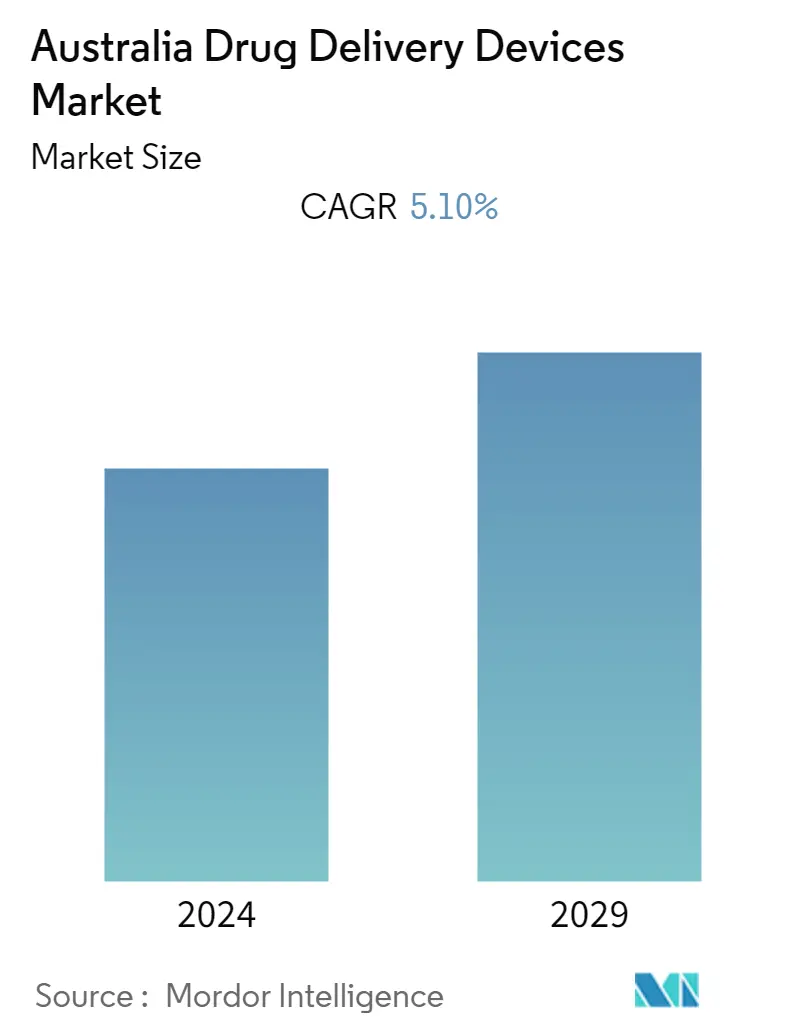
| Study Period | 2021 - 2029 |
| Base Year For Estimation | 2023 |
| Forecast Data Period | 2024 - 2029 |
| Historical Data Period | 2021 - 2022 |
| CAGR | 5.10 % |
Major Players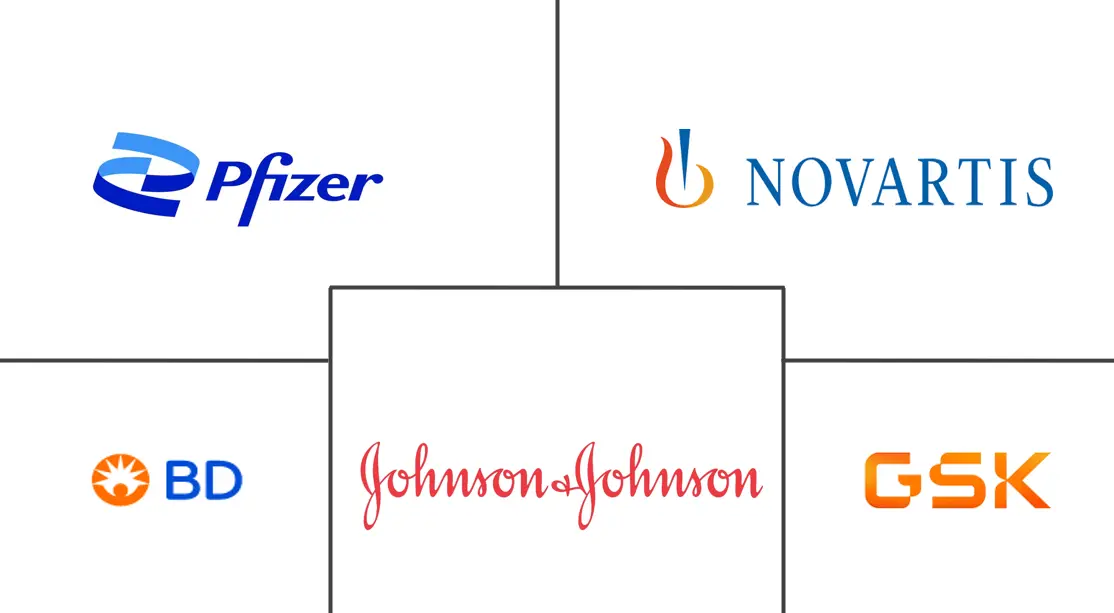
*Disclaimer: Major Players sorted in no particular order |
Australia Drug Delivery Devices Market Analysis
The Australian drug delivery device market is expected to register a CAGR of nearly 5.1% during the forecast period.
The COVID-19 pandemic impacted the Australian drug delivery device system. For instance, an article published in the journal Asia Pac. J. Clin. Oncol. in April 2022 reported that the pandemic has forced rapid system-wide changes to be implemented within cancer care clinical trials at an alarming rate, and new clinical trials for the COVID-19 vaccine and drug development were initiated. Thus, COVID-19 surged, increasing the number of clinical trials. However, in the current scenario with a decrease in COVID-19 cases and the emergence of other SARS-CoV-2 strains, the demand for drug delivery devices may keep on increasing in Australia, and the market is expected to witness significant growth over the forecast period.
The factors that are driving the growth of this market are the rising prevalence of chronic diseases and technological advancements. The rising prevalence of chronic diseases in the country is propelling the demand for increasingly technologically advanced drug delivery systems. For instance, in 2021, the International Diabetes Federation (IDF) reported that in Australia, in 2021, about 6.4% of people were living with diabetes, and this number is expected to increase by 8.0% by 2045. Thus, the high incidence of diabetes and rising demand for transdermal drug delivery devices for its treatment are likely to contribute to the growth of the studied market.
Similarly, in 2022, the Australian Institute of Health and Welfare reported that in the years 2020-2021, nearly 571,000 Australians aged 18 and over (2.9% of the adult population) had chronic heart diseases, based on self-reported data from the Australian Bureau of Statistics 2020-2021 National Health Survey. Thus, there is a high burden of cardiovascular diseases among the target population, increasing the demand for drug delivery devices in Australia.
Moreover, government support and initiatives for the development of new drugs in Australia are also contributing to the growth of this market. For example, in March 2022, the Australian Government Department of Health said that the government had paid for basic research that led to the development of different drug delivery devices.For instance, in August 2022, the Australian Government reached an in-principle agreement with the Victorian Government and global mRNA company Moderna to establish a new sovereign vaccine manufacturing facility in Australia. As a result, new drug delivery device developments contribute to market growth.
Furthermore, new product approvals are also contributing to the market's growth. For example, Novavax, Inc., a company that develops and commercializes next-generation vaccines for serious infectious diseases, announced in June 2022 that the Australian Therapeutic Goods Administration (TGA) had granted provisional registration of Nuvaxovid (NVX-CoV2373) COVID-19 vaccine as a booster in individuals aged 18 and over.
Thus, due to the rising prevalence of chronic diseases and technological advancements, the market is expected to witness significant growth over the forecast period. However, the risk of needlestick injuries may slow down the growth of the studied market.
Australia Drug Delivery Devices Market Trends
This section covers the major market trends shaping the Australia Drug Delivery Devices Market according to our research experts:
Cancer Segment is Estimated to Witness a Significant Growth Over The Forecast Period.
The oncology segment is expected to witness a significant share over the forecast period owing to the increasing prevalence of cancer cases in Australia. Cancer is a major cause of death and illness in Australia and has a substantial social and economic impact on individuals, families, and the community. For example, the Australian Institute of Health and Welfare reported in December 2021 that cancer accounts for 18% of the burden of ill health in Australians, and that over 1 million people in Australia are either currently living with cancer or have had it in the past.
Also, the increasing number of cancer cases is driving the growth of this segment. For instance, in 2020, the Globocan database reported that in Australia, cancer cases are expected to increase to 334.4 thousand by 2040. Thus, the high incidence of cancer cases is likely to drive the demand for oncology drug delivery devices and contribute to the growth of this segment.
Similarly, the partnerships and collaborations between key market players are contributing to the market's growth. For instance, in June 2022, EVERSANA and Accord BioPharma entered into a partnership to support the recent launch of CAMCEVI (leuprolide) 42 mg injection emulsion for the treatment of advanced prostate cancer in adults. Thus, such partnerships are leading to the development of better products, providing patients with better treatment, and driving the growth of the studied market.
So, because there are more people with cancer in Australia, the new treatments are likely to drive the growth of this segment over the next few years, which is likely to help the studied market grow.
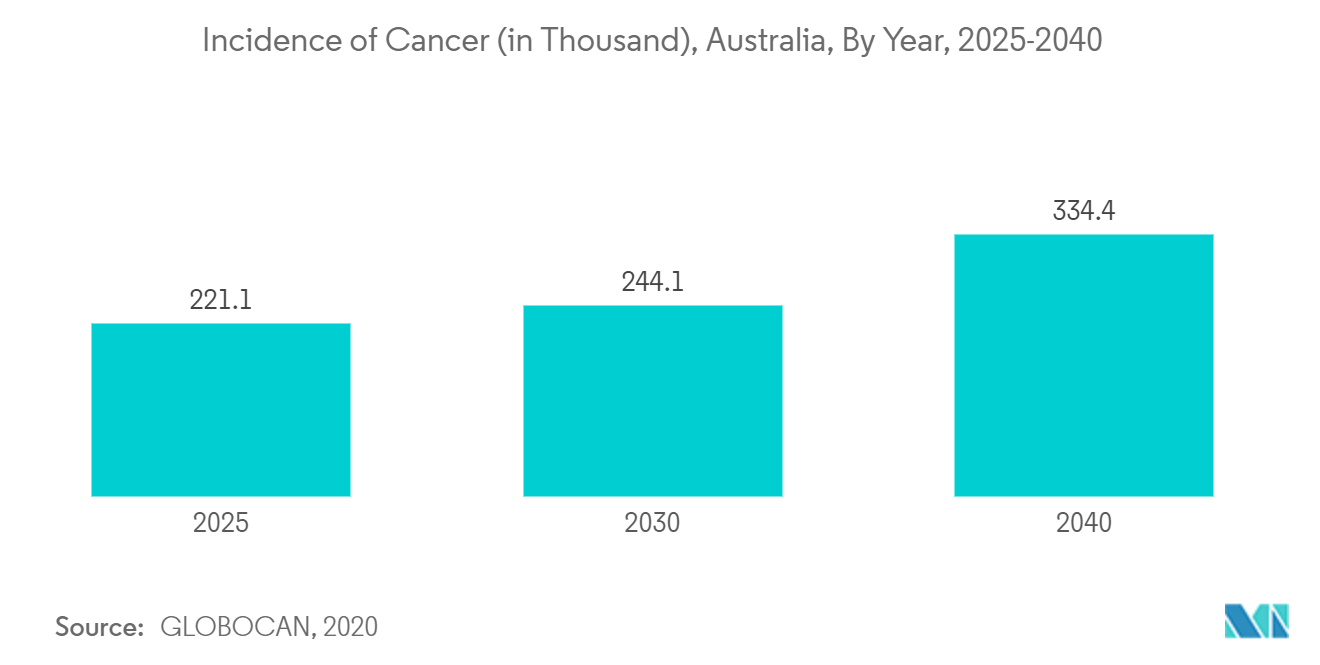
Injectable Segment is Expected to Witness High Growth Over the Forecast Period.
The rising number of people affected by chronic diseases in Australia and innovative product launches improve the adoption of self-care devices, which is expected to further boost the segment's growth over the forecast period.
The increasing number of cases of chronic diseases is driving the growth of this segment. For instance, in 2022, according to Australian Institute of Health and Welfare data updated in June 2022, almost 1.2 million hospitalizations were associated with diabetes, with 5% recording diabetes as the principal diagnosis and 95% recording diabetes as an additional diagnosis, which represented 11% of all hospitalizations in Australia. These statistics indicate the presence of a diabetes burden in the country. Hence, these disease burdens are anticipated to create demand for insulin and, thus, increase demand for syringes and injectables and contribute to the growth of this segment.
Moreover, as per the Medical Technology Association of Australia update in September 2021, at least 18,000 Australian healthcare professionals suffer from needlestick injuries every year, which creates a need for advanced self-care devices such as prefilled syringes. Thus, the high number of needlestick injuries is expected to create demand for injectables, further contributing to the growth of this segment.
Also, the high evidence of cardiovascular diseases among the geriatric population in Australia is propelling the growth of this segment. For instance, an article published in the journal Neural Computing & Applications in January 2021 reported that 21% of the geriatric population was living with cardiovascular diseases in Australia in the year 2020. Thus, the increasing geriatric population is driving the demand for injectables and thus contributing to the growth of this segment.
Also, new product launches are contributing to the growth of this segment. For instance, in July 2022, Moderna, Inc. reported that the TGA in Australia had granted provisional registration for the use of Moderna's mRNA COVID-19 vaccine, Spikevax, in a two-dose series of 25 g per dose for active immunization to prevent COVID-19 caused by SARS-CoV-2 in children aged 6 months to 5 years in Australia. Thus, such product launches are contributing to the growth of this segment.
Thus, due to the increasing cases of chronic diseases coupled with an increasing geriatric population and new product launches, the injectables segment is expected to witness high growth over the forecast period.
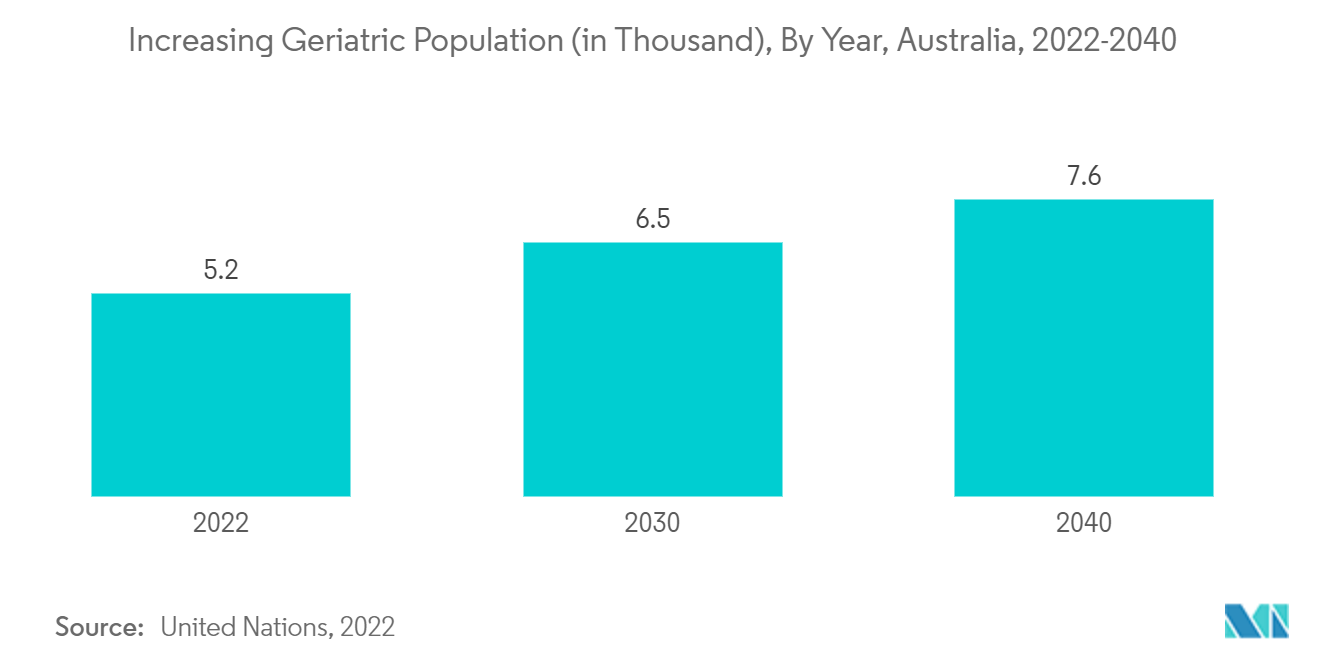
Australia Drug Delivery Devices Industry Overview
The Australian drug delivery device market is fragmented and competitive and consists of several major players. Some of the companies that are currently dominating the market are Viatris Inc. (Mylan N.V.), Novartis AG, GlaxoSmithKline Plc, Becton, Dickinson and Company, AbbVie Inc., Novo Nordisk, Johnson & Johnson, Sanofi AG, Teva Pharmaceutical Industries Ltd., Pfizer Inc., Bayer AG, and SiBiono GeneTech Co.
Australia Drug Delivery Devices Market Leaders
-
Novartis AG
-
GlaxoSmithKline Plc
-
Becton, Dickinson and Company
-
Johnson and Johnson
-
Pfizer, Inc.
*Disclaimer: Major Players sorted in no particular order
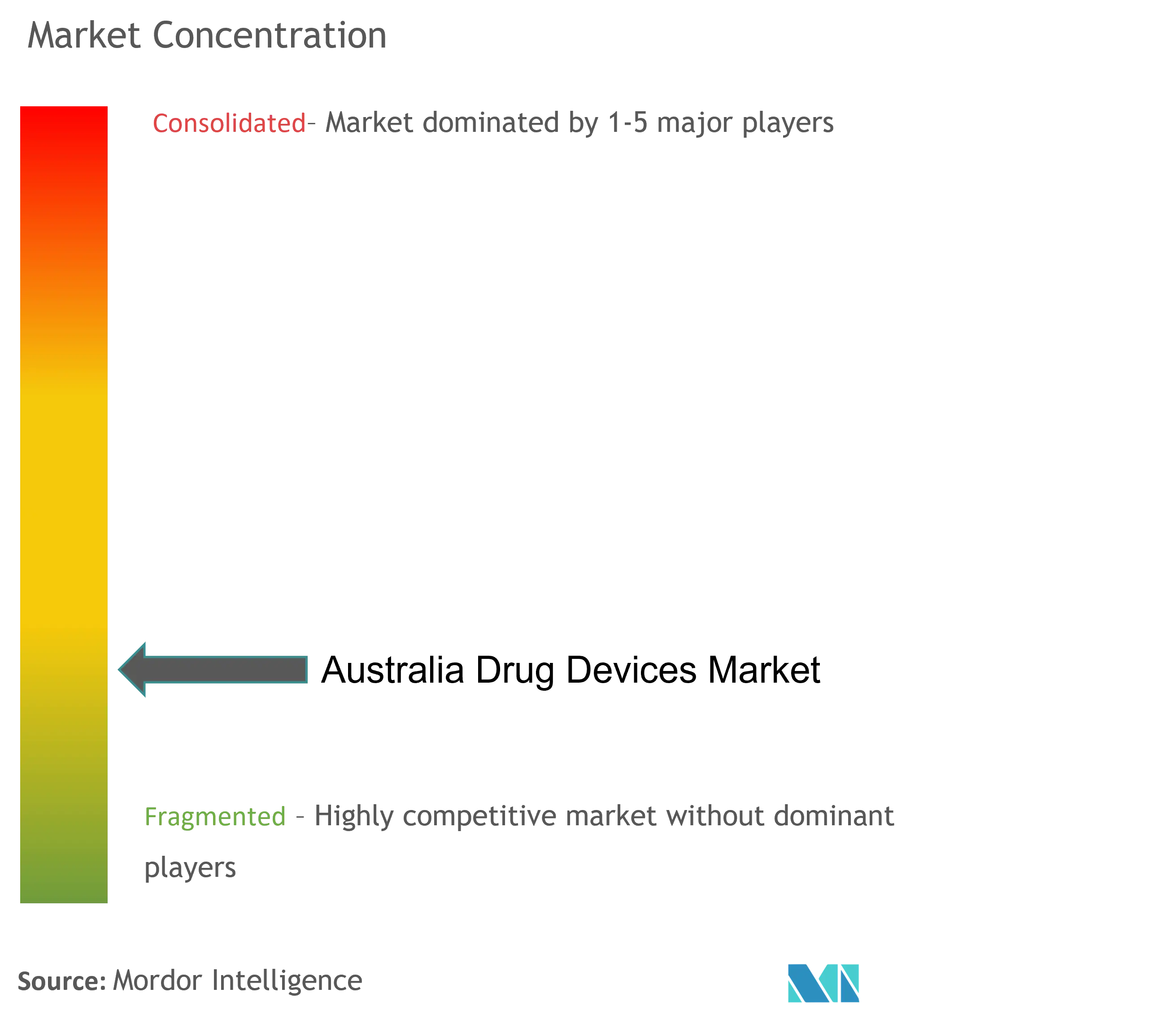
Australia Drug Delivery Devices Market News
- September 2022: BD introduced a next-generation glass refillable syringe (PFS) that sets a new standard in performance for vaccine PFS with new and tightened specifications for processability, cosmetics, contamination, and integrity. The device is available in Australia.
- May 2022: Terumo Pharmaceutical Solutions launched a pre-fillable polymer syringe for low-dose applications such as ophthalmic drugs. The PLAJEX 0.5-mL Luer Lock Silicone Oil-Free Prefillable Syringe is specifically designed for challenging low-dose Pre-Filled Syringe (PFS) products, making it suitable for high-value drug applications such as intravitreal injection, thus enabling the customers to offer a safe, easy-to-use, and effective treatment option for patients with ophthalmic disorders. The device is available in Australia.
Australia Drug Delivery Devices Market Report - Table of Contents
1. INTRODUCTION
- 1.1 Study Assumptions and Market Definition
- 1.2 Scope of the Study
2. RESEARCH METHODOLOGY
3. EXECUTIVE SUMMARY
4. MARKET DYNAMICS
- 4.1 Market Overview
-
4.2 Market Drivers
- 4.2.1 Rising Prevalence of Chronic Diseases
- 4.2.2 Technological Advancements
-
4.3 Market Restraints
- 4.3.1 Risk of Needlestick Injuries
-
4.4 Porter's Five Forces Analysis
- 4.4.1 Threat of New Entrants
- 4.4.2 Bargaining Power of Buyers/Consumers
- 4.4.3 Bargaining Power of Suppliers
- 4.4.4 Threat of Substitute Products
- 4.4.5 Intensity of Competitive Rivalry
5. MARKET SEGMENTATION (Market Size by Value - USD million)
-
5.1 By Route of Administration
- 5.1.1 Injectable
- 5.1.2 Topical
- 5.1.3 Ocular
- 5.1.4 Other Route of Administration
-
5.2 By Application
- 5.2.1 Cancer
- 5.2.2 Cardiovascular
- 5.2.3 Diabetes
- 5.2.4 Infectious diseases
- 5.2.5 Other Applications
-
5.3 By End User
- 5.3.1 Hospitals
- 5.3.2 Ambulatory Surgical Centers
- 5.3.3 Other End Users
6. COMPETITIVE LANDSCAPE
-
6.1 Company Profiles
- 6.1.1 Viatris Inc (Mylan N.V.)
- 6.1.2 Novartis AG
- 6.1.3 GlaxoSmithKline Plc
- 6.1.4 Becton, Dickinson and Company
- 6.1.5 AbbVie Inc
- 6.1.6 Novo Nordisk
- 6.1.7 Johnson & Johnson
- 6.1.8 Sanofi AG
- 6.1.9 Teva Pharmaceutical Industries Ltd
- 6.1.10 Pfizer, Inc.
- 6.1.11 Bayer AG
- 6.1.12 SiBiono GeneTech Co.
- *List Not Exhaustive
7. MARKET OPPORTUNITIES AND FUTURE TRENDS
** Subject To AvailablityAustralia Drug Delivery Devices Industry Segmentation
As per the scope, drug delivery devices or systems are the tools that are used to deliver the drug through a specific route of administration. It enables the introduction of therapeutic substances into the body.
The Australian Drug Delivery Devices Market is segmented by route of administration (injectable, topical, ocular, and other routes of administration), application (cancer, cardiovascular, diabetes, infectious diseases, and other applications),, and end user (hospitals, ambulatory surgical centers, and other end users). The report offers the value (in USD million) for the above segments.
| By Route of Administration | Injectable |
| Topical | |
| Ocular | |
| Other Route of Administration | |
| By Application | Cancer |
| Cardiovascular | |
| Diabetes | |
| Infectious diseases | |
| Other Applications | |
| By End User | Hospitals |
| Ambulatory Surgical Centers | |
| Other End Users |
Australia Drug Delivery Devices Market Research FAQs
What is the current Australia Drug Delivery Devices Market size?
The Australia Drug Delivery Devices Market is projected to register a CAGR of 5.10% during the forecast period (2024-2029)
Who are the key players in Australia Drug Delivery Devices Market?
Novartis AG, GlaxoSmithKline Plc, Becton, Dickinson and Company, Johnson and Johnson and Pfizer, Inc. are the major companies operating in the Australia Drug Delivery Devices Market.
What years does this Australia Drug Delivery Devices Market cover?
The report covers the Australia Drug Delivery Devices Market historical market size for years: 2021, 2022 and 2023. The report also forecasts the Australia Drug Delivery Devices Market size for years: 2024, 2025, 2026, 2027, 2028 and 2029.
Australia Drug Delivery Devices Industry Report
Statistics for the 2024 Australia Drug Delivery Devices market share, size and revenue growth rate, created by Mordor Intelligence™ Industry Reports. Australia Drug Delivery Devices analysis includes a market forecast outlook to 2029 and historical overview. Get a sample of this industry analysis as a free report PDF download.



